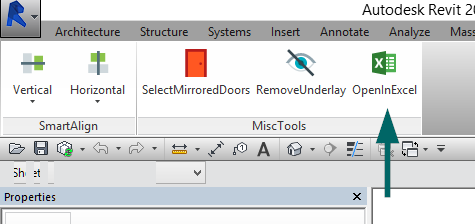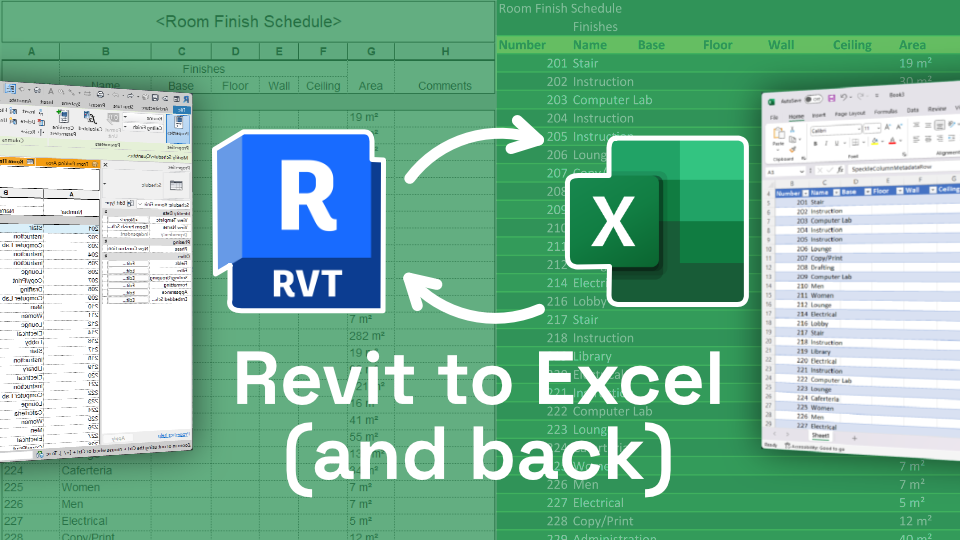Revit Tool Toolbox: Boost Your Layout Abilities
Wiki Article
Excel-to-Revit: A Game-Changing Process for Architectural Style - Introducing the Keys
Presenting excel-to-revit, the game-changing operations that will certainly reinvent your style process. With excel-to-revit combination, you can improve your architectural design, unlock performance, and maximize cooperation within your group. Get all set to take your building style to the next level with excel-to-revit!The Power of Excel-to-Revit Assimilation

Envision the benefit of having the ability to upgrade and edit project information in Excel, and instantaneously see those modifications reflected in your Revit version. No much more manual information entry or laborious updates. With Excel-to-Revit assimilation, you can conserve time and decrease mistakes by leveraging the power of Excel's functions and solutions to immediately produce accurate information in Revit.
Not only does this assimilation improve performance, yet it likewise enhances partnership among employee. You can quickly share Excel data with associates, who can after that import the information right into their Revit designs. This promotes a seamless exchange of details and guarantees that every person is collaborating with one of the most up-to-date data.

Improving Building Style With Excel-To-Revit
Streamlining architectural layout is simplified with making use of Excel-to-Revit (revit tool). With this effective assimilation, you can maximize your operations and save useful time throughout the style process. By leveraging the capabilities of Excel and Revit, you can effortlessly move data in between both platforms, removing the need for hands-on information access and minimizing the threat of errorsExcel-to-Revit enables you to import and export information effortlessly, allowing you to conveniently update and customize your building layouts. You can create routines, determine amounts, and produce records in Excel, and after that transfer that data directly right into your Revit version. This integration guarantees that your style details is constantly up-to-date and synchronized, getting rid of the requirement for hand-operated updates and decreasing the possibilities of incongruities.
By making use of Excel-to-Revit, you can also make use of the powerful computational capabilities of Excel. You can execute complicated estimations, examine information, and automate repeated jobs, all within Excel. Then, with simply a few clicks, you can import the results back into Revit, enabling you to make educated style decisions and enhance your architectural styles.
Opening Performance: Checking Out the Excel-to-Revit Process
Maximize your efficiency by perfectly integrating Excel and Revit for a more effective process. With the Excel-to-Revit process, you can unlock a whole brand-new degree of effectiveness in your architectural design procedure. By making use of the power of Excel's information administration capabilities and combining it with the adaptability and precision of Revit, you can improve your design procedure and conserve important time.Among the essential benefits of this combination is the capacity to import and export information in between Excel and Revit. This indicates that you can quickly move job information, such as area timetables or material quantities, from one software program to the various other, eliminating the demand for hands-on data access and minimizing the chances of mistakes. You can additionally develop custom-made formulas and estimations in Excel to automate repeated jobs and do complex estimations, which can then be flawlessly integrated right into your Revit models.
In Addition, the Excel-to-Revit process enables better control and partnership in between staff member. With Excel serving as a main information hub, numerous team participants can work with different facets of the task concurrently, sharing and updating info in real-time. This not just improves interaction yet also makes sure that every person is working with one of the most current data, getting rid of the threat of inconsistencies.
Maximizing Partnership: Excel-to-Revit for Architectural Teams
By seamlessly incorporating Excel and Revit, building teams can considerably improve cooperation and attain much more effective layout end results. When utilizing this powerful workflow, you can quickly transfer information in between Excel spread sheets and Revit versions, streamlining the design process and boosting interaction among staff member. With Excel-to-Revit combination, you can easily import task information, such as area schedules, material quantities, and task parameters, directly right into Revit, eliminating the need for manual data entry and reducing the possibilities of errors. This seamless connection allows for real-time updates, ensuring that everyone is collaborating with the most current details and staying clear of disparities in between various files.Furthermore, by leveraging Excel's effective estimation abilities, you can carry out intricate estimations and analysis on your layout information, driving and offering valuable understandings informed decision-making. This assimilation likewise enables you to export information from Revit to Excel, enabling you to develop extensive records, charts, and charts for presentations and evaluation. This collective workflow advertises effective interaction and coordination amongst staff member, as Excel works as a central center for data monitoring and sharing.
Overall, by welcoming the Excel-to-Revit workflow, building groups can accomplish greater levels of partnership, efficiency, and accuracy in their layout process. revit tool. This integration encourages teams to interact perfectly, making certain that everybody gets on the very same page and adding to the success of the task
Unveiling the Tricks of Excel-to-Revit Assimilation

One of the tricks of Excel-to-Revit combination is the capacity to leverage the power of formulas and computations in Excel to drive criteria and create complex geometries in Revit. You can link Excel spreadsheets to Revit households, enabling you to input data straight right into the spreadsheet and have it automatically update in the Revit version. This simplifies the design process and guarantees precision and uniformity throughout the task.
An additional secret is the ability to create customized routines and records in Excel, utilizing information drawn out from Revit. This permits you to visualize and analyze project information in a way that is not possible within Revit alone. You can easily produce amount take-offs, expense price quotes, and task timelines, supplying valuable insights for decision-making and project management.
Furthermore, Excel-to-Revit integration allows effective partnership among employee. Numerous individuals can deal with the same Excel spreadsheet simultaneously, making it easier to coordinate and track adjustments. You can additionally utilize Excel's commenting feature to provide responses or interact style revisions.
Final Thought
By incorporating the power of Excel and Revit, engineers can currently work a lot more successfully, save time, and produce much better designs. Start incorporating excel-to-revit assimilation right into your building style process today and revolutionize the means you function.With just a few clicks, you can import the outcomes back right into Revit, enabling you to make educated design choices and maximize your architectural designs.
By utilizing the power of Excel's information administration abilities and combining it with the adaptability and accuracy of Revit, you can improve your design procedure and save important time.
By seamlessly incorporating Excel and Revit, architectural groups can considerably improve cooperation and accomplish much more efficient style outcomes. When utilizing this powerful workflow, you can quickly transfer information between Excel spread sheets and Revit designs, simplifying the style process and boosting communication amongst team participants.Additionally, by leveraging Excel's effective computation capabilities, you can do complex estimations and analysis on your layout data, driving and offering beneficial insights notified decision-making.
Report this wiki page